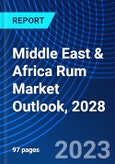This report comes with 10% free customization, enabling you to add data that meets your specific business needs.
1h Free Analyst TimeSpeak directly to the analyst to clarify any post sales queries you may have.
According to the research report Middle East & Africa Rum Market Outlook, 2028, The market is projected to reach market size more than USD 641 Million by 2028.Captain Morgan, Havana Club, Mount Gay, Appleton Estate, Takamakaare some brands in Mea .Hospitality and socializing play a vital role in the market culture of the MEA region. Sharing drinks, including rum, is often a part of social gatherings, family celebrations, and business meetings. The act of offering and enjoying rum together is seen as a way to build relationships and strengthen bonds. The rum market in the MEA region is witnessing growth due to increasing demand, expanding consumer base, premiumization, tourism influence, local craft distilleries, e-commerce, and diverse regulatory environments. Opportunities in the MEA rum market include capitalising on the trend towards premium and craft spirits, targeting the tourism and travel retail sector, highlighting local sourcing and authenticity, utilising the expansion of online retail and e-commerce, and launching flavor- and innovation-forward rum variants that are tailored to regional tastes.
Both conventional and flavored rums are in high demand in the Middle East and Africa (MEA) area. It is important to remember that the MEA region tends to have a larger traditional rum market, especially for aged and premium varieties. Customers in these areas value the workmanship, authenticity, and distinctive flavors that traditional rum producing techniques offer. Additionally, as consumers seek for novel and inventive flavor sensations, the popularity of spiced and flavored rums is rising. Overall, flavored rum is growing in popularity in the MEA market as consumers seek out unique and experimental flavor profiles, even while conventional rum continues to have a substantial market share. The MEA region attracts a large number of international tourists, creating opportunities for rum sales in duty-free shops and travel retail outlets. These channels cater to travelers looking to purchase souvenirs or experience local flavors. Hotels, bars, restaurants, and nightclubs form an important distribution channel for rum in the MEA region. The vast size and diverse geography of the MEA region can pose distribution and logistical challenges for rum brands. Ensuring efficient and reliable distribution networks, especially in remote or less-developed areas, may require significant investments in infrastructure and supply chain management.
The rum market in the MEA region faces restraints including regulatory challenges, cultural and religious factors, taxation and import duties, limited market awareness, distribution and logistics complexities, and the presence of counterfeit products. Overcoming these restraints requires navigating complex regulations, addressing cultural sensitivities, managing costs, raising market awareness, establishing efficient distribution networks, and protecting against counterfeits. By understanding and addressing these challenges, rum brands can position themselves for success in the MEA market. Rum in the MEA region is produced using sugarcane juice or molasses, which undergo fermentation with yeast to convert sugars into alcohol. The resulting wash is then distilled using pot stills or column stills to separate impurities and concentrate flavors. Some rum varieties are aged in wooden barrels or casks to develop complexity. Finally, the aged rum is blended and bottled for distribution. The specific production methods and ingredients can vary among different MEA countries, leading to a diverse range of rum styles and flavor profiles in the region.
South Africa has a growing domestic rum production industry. Distilleries in the country produce a variety of rum styles, ranging from white and spiced rums to aged and premium offerings. South Africa has suitable climate conditions for growing sugarcane, a key ingredient in rum production. South Africa is a popular tourist destination, attracting a significant number of international visitors. The tourism industry provides opportunities for rum sales, as tourists often seek to explore local flavors and experiences, including trying locally produced rums. South Africa's cultural diversity and heritage make it an appealing market for rum brands.Like in other parts of the world, there is a growing trend towards premium and craft spirits in South Africa.
Considered in this report
- Geography: Middle East and Africa
- Historic year: 2017
- Base year: 2022
- Estimated year: 2023
- Forecast year: 2028
Aspects covered in this report
- Middle East and Africa Rum market with its value and forecast along with its segments
- Country-wise Rum Market analysis
- Various drivers and challenges
- On-going trends and developments
- Top profiled companies
- Strategic recommendation
Countries covered in the report:
- United Arab Emirates
- South Africa
By Types Rum
- White Rum
- Light or Gold Rum
- Dark Rum
- Spiced and Flavored
By Nature
- Conventional
- Organic
By Category
- Standard
- Over proof
By Segment
- Mass
- Premium /Craft Rum
By Distribution Channel
- On -Trade
- Off-Trade








